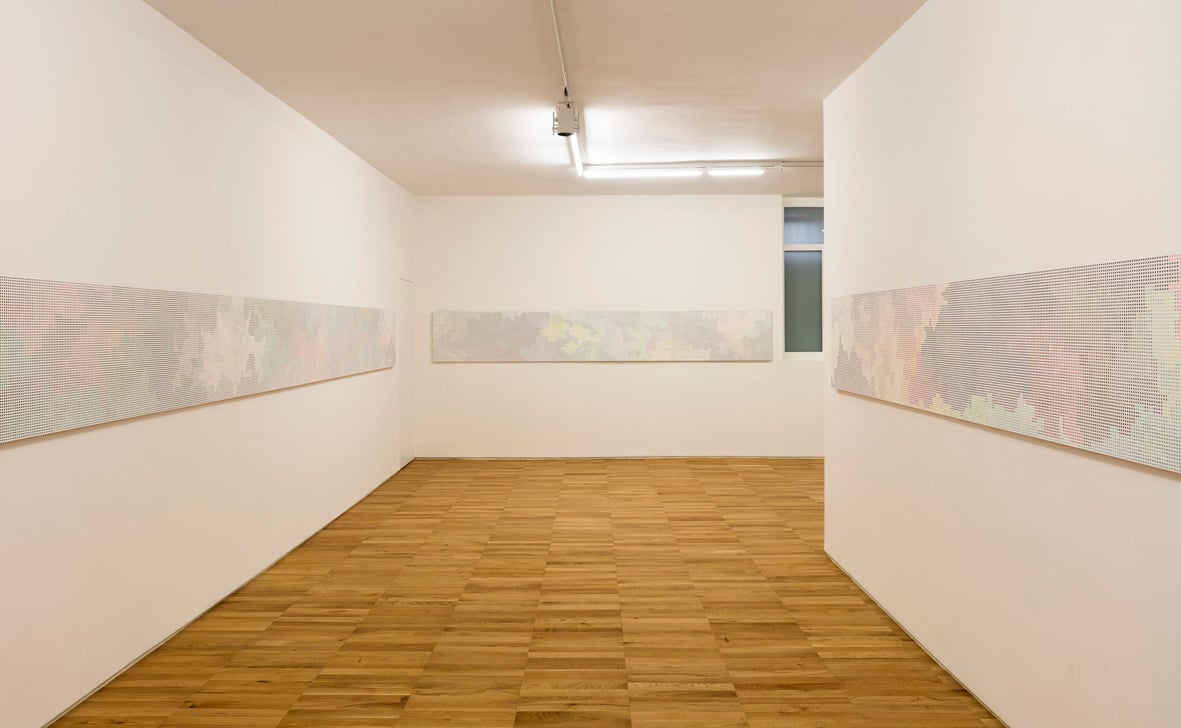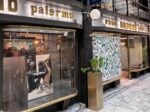Cheyney Thompson – Bird Shells and Chambered Wings

Per la quarta personale presso Raucci/Santamaria, Cheyney Thompson (nato a Baton Rouge, Louisiana, 1975, vive e lavora a New York) presenta una serie di dipinti che concludono una nuova ed ultima serie di opere. Lavori che continuano ad essere indirizzati a ulteriori analisi sulla tecnologia, distribuzione e veicolazione della pittura.
Comunicato stampa
“Guardò oltre Chin, verso flussi di numeri che scorrevano in direzioni opposte. Capì quanto significasse per lui, il movimento dei dati su uno schermo. Esaminò i diagrammi figurativi che si rifacevano a modelli organici, ala d'uccello e conchiglia spiraliforme. Era pura superficialità affermare che numeri e grafici fossero la fredda compressione di turbolenti energie umane, desideri e sudate notturne ridotte a lucide unità sui mercati finanziari. In realtà i dati stessi erano pieni di calore e passione, un aspetto dinamico del processo della vita. Quella era l'eloquenza di alfabeti e sistemi numerici, ora pienamente realizzata in forma elettronica, nel sistema binario del mondo, l'imperativo digitale che definiva ogni respiro di miliardi di esseri viventi del pianeta. Lì c'era il palpito della biosfera. I nostri corpi e oceani erano lì, integri e conoscibili.” Don DeLillo, Cosmopolis, Scribner, New York, 2003
Per la quarta personale presso Raucci/Santamaria, Cheyney Thompson (nato a Baton Rouge, Louisiana, 1975, vive e lavora a New York) presenta una serie di dipinti che concludono una nuova ed ultima serie di opere. Lavori che continuano ad essere indirizzati a ulteriori analisi sulla tecnologia, distribuzione e veicolazione della pittura.
Prendendo in prestito modelli algebrici ed algoritmi presenti nella struttura e nello studio della statistica, applicati ai processi economici e finanziari, l’artista tenta di tradurre in una rappresentazione bidimensionale pittorica la dimensione astratta dei dati che la compongono.
Thompson prova, nell’uso del colore, a creare una struttura di fondo combinando modelli standardizzati, in uso nel sistema del pittore ed inventore Albert Henry Munsell. Questo sistema dei colori o più semplicemente sistema Munsell è uno spazio dei colori usato come standard internazionale per definire i colori in base a tre coordinate dimensionali: tonalità, luminosità e saturazione. Sistema che venne creato da Munsell all'inizio del XX secolo e adottato negli anni trenta dal Dipartimento dell'Agricoltura degli Stati Uniti d'America come sistema di colori ufficiale per le ricerche sul suolo e tuttoggi applicato graficamente nei prospetti statistici relativi ad agricoltura e industria. Nel contempo i dati risultanti dal set dei valori del colore sono stati poi utilizzati per creare un modello spaziale di tutti i colori derivati dalle dimensioni della galleria e poi tradotti nelle opere esposte. In questo modello spaziale Thompson ha inserito un'entità teorica, una unità immaginaria, che in statistica viene chiamata Stocastica. Un dato arbitrario che viene introdotto per verificare un calcolo probabilistico di possibili dimensioni spaziali e tradotti in passi casuali o passeggiate, definiti in una cosiddetto "random walk". Un "casuale" che appartiene allo studio di alcuni tipi di movimento apparentemente non legati ad un preciso ordine e soprattutto presenti nelle osservazioni del botanico Robert Brown che nel 19° secolo studiò i pollini che galleggiano sull'acqua. Osservazioni che furono poi ordinate in schemi e formule dal matematico Louis Bachelier e successivamente usati nei modelli delle fluttuazioni dei mercati azionari e finanziari agli inizi del 900. In questo caso il "casuale" presente nel soggetto di Thompson produce una nuova sequenza di valori del colore, mappato da una griglia fatta di piccoli quadrati in un percorso contiguo , non intersecanti, e che diventa simile ad uno schema grafico computerizzato. Una dimensione che cerca di dare forma e visibilità al movimento continuo dei flussi di dati e codici che incessantemente si moltiplicano in un apparente caos per noi non percettibili se non fissati e tradotti nella contemplazione delle opere.
Cheyney Thompson ha avuto personali al MIT List Visual Arts Center, Cambridge, Massachusetts e al Kunstverein Braunschweig, Germany; il suo lavoro è stato incluso nel 2008 al Whitney Biennial - Une Histoire, Centre Pompidou, Paris, France, Chat Jet - Painting ‘Beyond’ The Medium at Künstlerhaus Graz; The Indiscipline of Painting, Tate St. Ives, England; Systems Analysis at West London Projects and Langen Foundation, Germany; Greater New York al P.S.1 Contemporary Art Center e nella Biennale di Venezia nel 2003.
“He looked past Chin toward streams of numbers running in opposite directions. He understood how much it meant to him, the roll and flip of data on a screen. He studied the figural diagrams that brought organic patterns into play, birdwing and chambered shell. It was shallow thinking to maintain that numbers and charts were the cold compression of unruly human energies, every sort of yearning and midnight sweat reduced to lucid units in the financial markets. In fact data itself was soulful and glowing, a dynamic aspect of the life process. This was the eloquence of alphabets and numeric systems, now fully realized in electronic form, in the zero-oneness of the world, the digital imperative that defined every breath of the planet's living billions. Here was the heave of the biosphere. Our bodies and oceans were here, knowable and whole.” - Don DeLillo, Cosmopolis, Scribner, New York, 2003
For his fourth solo exhibition with Raucci/Santamaria, Cheyney Thompson (born 1975, Baton Rouge, Louisiana; lives and works in New York) is presenting a series of paintings that conclude his latest series of works. These works continue to focus on further analysis of the technology, distribution and circulation of painting.
Drawing on algebraic models and algorithms present in the structure and study of statistics, applied to economic and financial processes, the artist takes the abstract dimension of the data composing it and attempts to translate it into a two-dimensional pictorial representation.
In his use of color, Thompson tries to create a basic structure combining standardized models used in the system of the painter and inventor Albert Henry Munsell. This color system – or simply the Munsell system – is a spatial representation used as an international standard to define colors based on three dimensional coordinates: hue, value (lightness) and chroma (color purity). Munsell created the system in the early twentieth century and in the 1930s the United States Department of Agriculture adopted it as its official color system for soil research. Even today, it is applied graphically in statistical tables regarding industry and agriculture. The artist took the data resulting from the set of color values to create a spatial model of all the colors derived from the dimensions of the gallery and then translated them into the exhibited works. Thompson has inserted a theoretical entity into this spatial model, an imaginary unit referred to in statistics as stochastic. An arbitrary datum is introduced to check a probabilistic calculation of possible spatial dimensions, translated into a sequence of random steps defined as a “random walk”. This “random walk” comes from the study of certain types of movement that are seemingly not tied to a precise order and that, above all, can be noted in the observations of the nineteenth-century botanist Robert Brown, who studied pollen floating on water. In the early twentieth century, mathematician Louis Bachelier then organized these observations into models and formulas he used for models of the fluctuation of stock and financial markets. In this case, the “random walk” present in Thompson’s subject produced a new sequence of color values, which he mapped onto a grid composed of small squares, in a contiguous non-intersecting path resembling a computerized graphic diagram. This is a dimension that strives to lend form and visibility to the continuous movement of the flow of data and codes that multiply perpetually in seeming chaos and that we can only perceive if they are captured and translated through the contemplation of these works.
Cheyney Thompson has had solo exhibitions at the MIT List Visual Arts Center, Cambridge, Massachusetts, and the Kunstverein Braunschweig, Germany. His work was included in 2008 Whitney Biennial, New York; “Une Histoire”, Centre Pompidou, Paris; “Chat Jet – Painting ‘Beyond’ The Medium” at Künstlerhaus Graz; “The Indiscipline of Painting”, Tate St. Ives, England; “Systems Analysis” at West London Projects and the Langen Foundation, Germany; “Greater New York” at the P.S.1 Contemporary Art Center, New York; and the Venice Biennale (2003).



